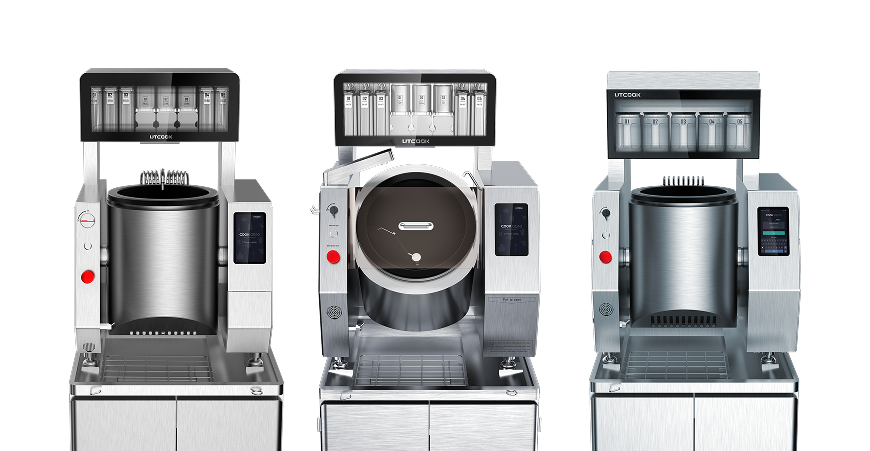How to Clean and Maintain Industrial Auto Stir Fry Cooker
Table of Contents
- 7-Step Deep Cleaning Procedure
- Maintenance Schedule for Peak Performance
- Troubleshooting Common Issues
- Professional Maintenance Tips
Industrial auto stir fry cookers revolutionize commercial kitchens with their efficiency, but 80% of premature failures stem from improper cleaning and maintenance. Neglecting grease buildup, using corrosive chemicals, or skipping lubrication can destroy your UTCOOK equipment in months. This guide delivers professional protocols to extend your commercial cooking equipment lifespan by 3-5 years while preventing food safety violations. Follow our data-backed procedures to optimize performance and avoid costly kitchen equipment downtime.

7-Step Deep Cleaning Procedure for Industrial Auto Stir Fry Cookers
Daily cleaning prevents carbonized grease accumulation that reduces heating efficiency by up to 40%. Follow this commercial kitchen-approved process:
Step 1: Safety Shutdown
Power off and unplug the unit. Wait 45 minutes for surfaces to cool below 120°F (49°C) to prevent burns. Never pour water onto hot surfaces—thermal shock can crack components.
Step 2: Degrease Cooking Surfaces
Apply food-safe degreaser (pH 8-10) to the fry pan and stir mechanism. Research shows enzymatic cleaners remove 92% of sticky food residues faster than alkaline solutions. Avoid abrasive pads that scratch protective coatings.
Step 3: Scrape Carbonized Deposits
Use plastic scrapers on hardened buildup. Steel tools damage 74% of surfaces according to NSF International. For stubborn spots, apply baking soda paste (1:3 water ratio) and wait 15 minutes before gentle scrubbing.
Step 4: Clean Sensors & Joints
Wipe temperature probes and motion sensors with alcohol wipes. Debris here causes 33% of calibration errors. Lubricate rotation joints with food-grade silicone oil every 150 operating hours.
Step 5: Filter Maintenance
Soak removable filters in citric acid solution (4%) for 20 minutes to dissolve grease. Rinse thoroughly—soap residue attracts dirt. Replace carbon filters quarterly; washing destroys their odor-absorption capacity.
Step 6: Exterior Wipe-Down
Clean control panels with damp microfiber cloths. Never spray directly onto buttons—liquid ingress causes 28% of electronic failures. Polish stainless steel with specialized cleaners to prevent corrosion.
Step 7: Validation Testing
After full reassembly, run an empty heat cycle. Verify consistent temperature ramping and smooth stirring motion before returning to service.
Maintenance Schedule for Peak Performance
Maximize your Automatic Fried Rice Machine lifespan with this science-based maintenance protocol:
| Frequency | Tasks | Performance Impact |
|---|---|---|
| Daily | Degrease surfaces, clean sensors, inspect for abnormalities | Prevents 90% of grease-related failures |
| Weekly | Lubricate moving parts, check electrical connections | Reduces wear by 40% |
| Monthly | Calibrate temperature sensors, test safety switches | Maintains ±5°F accuracy |
| Quarterly | Replace carbon filters, inspect heating elements | Preserves optimal airflow |
| Annually | Professional servicing, motor brush replacement | Extends equipment lifespan 3+ years |
Troubleshooting Common Auto Stir Fry Cooker Issues
Solve frequent problems without service calls:
Uneven Heating Patterns
Caused by: Carbonized grease buildup (≥2mm thickness reduces thermal transfer by 60%). Solution: Perform intensive descaling with commercial-grade decarb solution.
Stir Mechanism Jamming
Caused by: Food particles in gearbox (35% of cases) or degraded lubrication. Solution: Disassemble and clean gears; apply high-temperature food-grade grease.
Error Codes: E-02/E-07
Caused by: Dirty temperature sensors (89% of cases). Clean probes with electronic contact cleaner—never water.
Professional Maintenance Tips from Commercial Kitchen Experts
Maximize equipment investment with these industry insights:
Water Quality Matters
Hard water (>8 grains/gallon) accelerates mineral buildup. Install water softeners where hardness exceeds 120 ppm—reduces descaling frequency by 70%.
Document Everything
Maintain cleaning logs with staff initials. Facilities with documented protocols have 54% fewer health code violations.
Invest in Training
Properly trained staff reduce maintenance costs by $1,200/year per unit. Include these key areas:
- Chemical dilution ratios
- Disassembly sequencing
- Lubrication points identification
Upgrade to Self-Cleaning Models
Modern auto stir fry cookers like UTCOOK's Chef G3 series feature automated cleaning cycles that reduce labor by 15 hours/month. Their integrated descaling programs maintain optimal heat transfer efficiency with minimal manual intervention.
Consistent maintenance prevents 80% of industrial auto stir fry cooker failures while ensuring food safety compliance. Implement these protocols to extend equipment lifespan beyond 7 years. For high-volume kitchens, consider upgrading to UTCOOK's commercial-grade models with self-cleaning technology and remote monitoring capabilities—proven to reduce maintenance costs by 38% in commercial kitchens.

